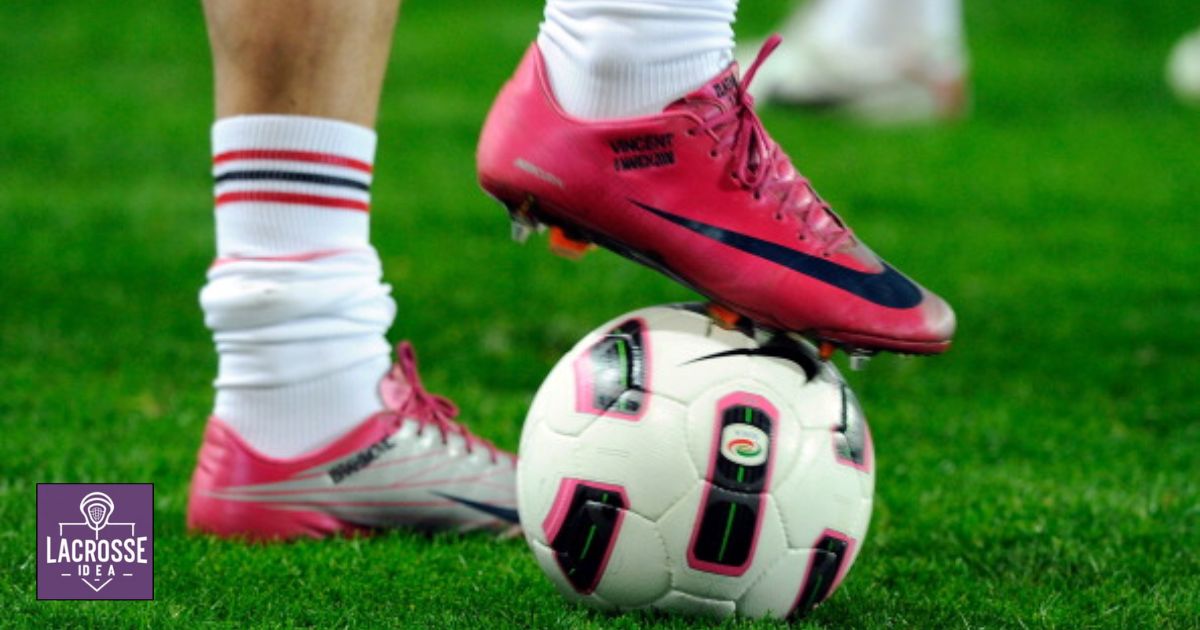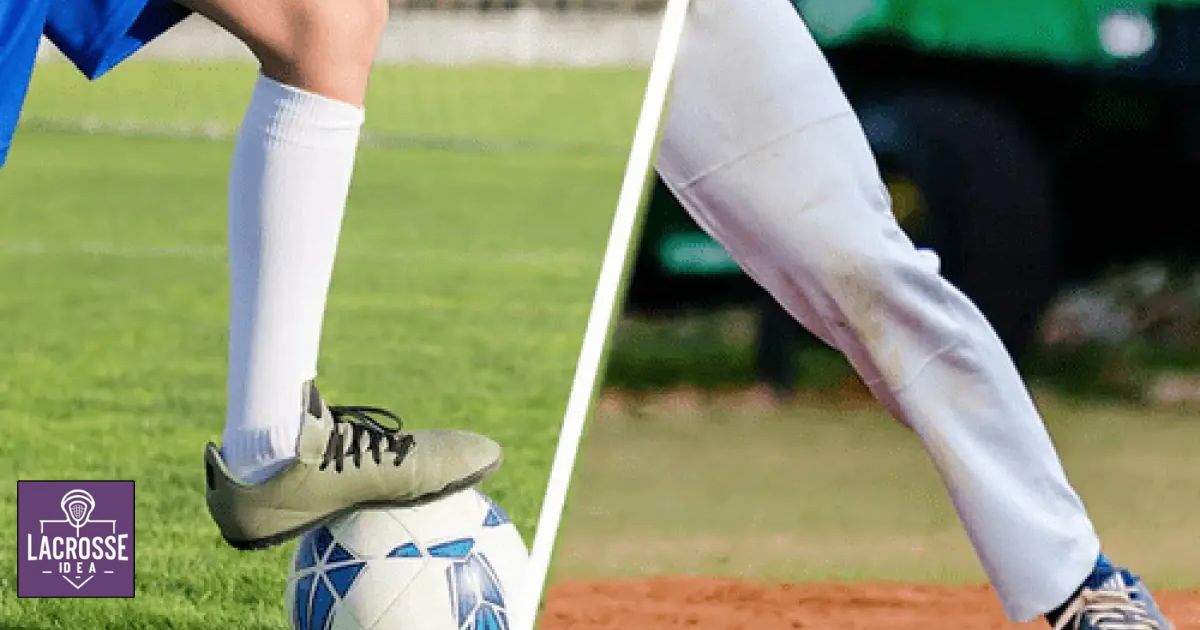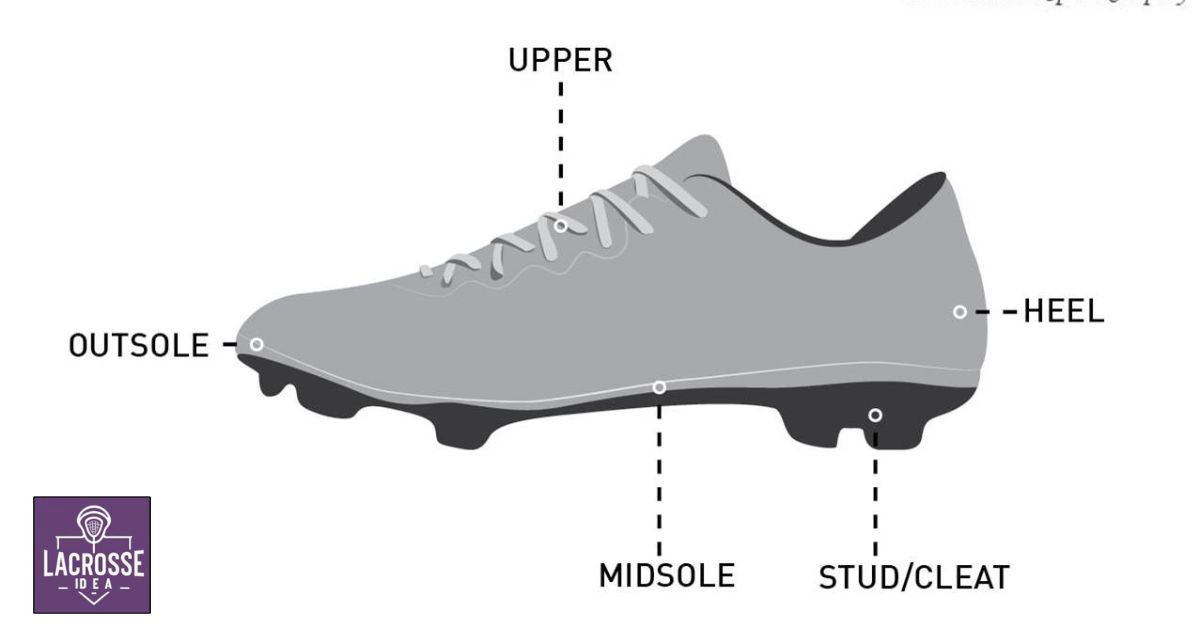Are you ready to dominate the lacrosse field with the perfect pair of cleats? Picture this: a player gliding effortlessly across the turf, their agile movements supported by the ideal footwear. But can football cleats provide the same level of performance? In this article, we will explore the similarities and differences between football and lacrosse cleats, uncovering the key factors to consider when choosing the right footwear to elevate your game. Join us as we delve into the intricacies of traction, ankle support, flexibility, durability, and more.
Key Takeaways
- Football cleats are designed for grass or turf surfaces and provide excellent grip and stability.
- Lacrosse cleats prioritize agility and quick movements with shorter and more numerous studs for better traction.
- Football cleats have a high-top design for maximum ankle support, while lacrosse cleats have a mid-top design for greater mobility.
- Lacrosse cleats are engineered for flexibility, durability, and optimized performance in the sport, while football cleats may not be suitable for lacrosse-specific movements and field conditions.
Understanding the Differences in Field Surfaces
Understanding the differences in field surfaces is crucial when determining whether football cleats can be used for lacrosse. When comparing turf and grass fields for lacrosse, it is essential to consider the specific requirements of the sport. Turf fields are becoming increasingly popular in lacrosse due to their consistent playing surface, which allows for predictable ball movement and player traction. Grass fields, on the other hand, offer a more natural playing experience but can be affected by weather conditions.
Evaluating the impact of weather conditions on field surfaces in lacrosse is important because rain or excessive heat can significantly alter the playing surface. Wet grass fields can become slippery, while dry grass fields can become hard and unforgiving. Therefore, understanding the differences between turf and grass fields and considering the impact of weather conditions is essential when deciding whether football cleats can be used for lacrosse.
Traction Requirements in Lacrosse Vs. Football
When comparing the traction requirements in lacrosse and football, it is important to consider the specific demands of each sport. Traction is crucial in both sports, as players need to quickly change direction, accelerate, and decelerate on the field. However, there are some differences in the traction needs for each sport.
In football, players often require more traction due to the physical nature of the game. Football cleats are designed to provide excellent grip on grass or turf surfaces, allowing players to maintain their footing during tackles and cuts. These cleats typically have longer and sharper studs, which penetrate the ground more deeply for added stability.
On the other hand, lacrosse cleats focus more on agility and quick movements. Lacrosse players need to be able to make lateral moves, dodge opponents, and change direction rapidly. Therefore, lacrosse cleats usually have shorter and more numerous studs, which provide better traction for these types of movements.
Ankle Support: How Does It Differ
The difference in ankle support between football and lacrosse cleats is a significant factor to consider when determining their suitability for each sport. Ankle stability is crucial in both football and lacrosse, as players often make quick cuts and changes in direction, putting their ankles at risk of injury. However, the design of the cleats differs in terms of ankle support to address the specific demands of each sport.
For football cleats:
- High-top design provides maximum ankle support, reducing the risk of sprains and other ankle injuries.
- Sturdy materials and padding offer additional stability and protection.
For lacrosse cleats:
- Mid-top design offers moderate ankle support while allowing for greater mobility and agility.
- Lightweight construction allows players to move quickly and change directions effortlessly.
The Importance of Flexibility in Lacrosse Cleats
Flexibility is a crucial aspect to consider when evaluating the suitability of football cleats for use in lacrosse. Lacrosse is a sport that requires quick and agile movements, and the flexibility of the cleats plays a significant role in providing comfort and enhancing performance on the field. The impact of cleat design on flexibility cannot be overlooked, as it directly affects the player’s ability to make sharp cuts, change direction swiftly, and maintain balance.
To illustrate the importance of flexibility in lacrosse cleats, consider the following table:
| Cleat Model | Flexibility Rating |
|---|---|
| Model A | High |
| Model B | Medium |
| Model C | Low |
As shown in the table, different cleat models offer varying degrees of flexibility. It is essential for lacrosse players to choose cleats that provide the right balance of flexibility and support, ensuring both comfort and optimal performance on the field.
Exploring the Importance of Durability
Durability is a crucial aspect to consider when choosing cleats for lacrosse. The lifespan of the cleats is important because lacrosse involves a lot of running and quick movements, which can put a strain on the footwear. Additionally, while football cleats may be durable, it is important to assess their longevity for lacrosse-specific movements and field conditions.
Cleat Lifespan in Lacrosse
A long-lasting cleat lifespan is crucial in lacrosse, ensuring players have the necessary traction and stability on the field. In a sport that involves quick movements, sudden changes in direction, and physical contact, durable cleats are essential for optimal performance and player safety. Here are some key factors to consider regarding cleat lifespan in lacrosse:
- Cleat durability in soccer:
- Soccer cleats are designed to withstand the demands of a sport that involves running, kicking, and sliding on various surfaces. However, the specific movements and field conditions in lacrosse differ from soccer, requiring cleats that can handle the unique challenges of the game.
- Soccer cleats may not provide the necessary support and durability needed for the high-intensity movements and physicality of lacrosse.
- Cleat durability in rugby:
- Rugby cleats are designed to withstand the rigors of a game that involves intense physical contact, tackling, and scrums. While rugby cleats may offer better durability than soccer cleats, they may still not be optimized for the specific requirements of lacrosse.
- Lacrosse cleats are engineered to provide the right balance of traction, support, and durability needed for the sport. They feature reinforced materials, robust outsoles, and specialized stud configurations to enhance performance and withstand the demands of the game.
Investing in lacrosse-specific cleats will ensure that players can perform at their best while minimizing the risk of injuries caused by inadequate footwear.
Longevity of Football Cleats
The longevity of football cleats is an essential consideration when evaluating their suitability for lacrosse. Lacrosse is a physically demanding sport that requires players to make quick movements and sharp cuts on the field. The durability of the cleats becomes crucial in providing the necessary support and traction needed for optimal performance. Football cleats are designed to withstand the rigors of football, which includes tackling and running on various surfaces.
However, lacrosse cleats are specifically engineered to meet the unique demands of the sport. They are designed to provide excellent grip on grass and turf fields, while also offering durability and protection against wear and tear. Therefore, while football cleats may be used for lacrosse in certain situations, it is recommended to invest in lacrosse-specific cleats for long-term performance and safety.
Considering Cleat Weight for Optimal Performance
Lightweight cleats are essential for optimal performance in lacrosse. The weight of the cleats can significantly impact the player’s speed, agility, and overall comfort on the field. When considering cleat weight, it is important to compare the materials used in their construction. Here are two sub-lists to help paint a clearer picture:
Cleat Weight Impact:
- Lighter cleats allow players to move quickly and change direction with ease, enhancing their performance during fast-paced lacrosse games.
- Heavy cleats can weigh down the player’s feet, making it harder to sprint, jump, and maneuver effectively on the field, potentially hindering their performance.
Cleat Material Comparison:
- Synthetic materials are often lighter than leather, making them a popular choice for lacrosse cleats.
- Cleats made from lightweight materials, such as mesh or synthetic leather, provide a balance between durability and reduced weight, offering players optimal performance and comfort.
Choosing lightweight cleats made from suitable materials is crucial for lacrosse players aiming for optimal performance on the field.
Examining the Design and Construction of Football Cleats
Football cleats are designed and constructed specifically for the sport of football, with features that cater to the unique demands of the game. One key aspect of their design is the differences in cleat stud patterns. Football cleats typically have a combination of studs in different shapes and sizes strategically placed on the outsole to provide optimal traction and stability on the field. The stud patterns vary based on the position and playing style, with lineman cleats having larger, more aggressive studs for better grip on the turf.
Another important factor in the design of football cleats is the evaluation of cleat materials. Manufacturers use lightweight yet durable materials such as synthetic leather and mesh to ensure flexibility, breathability, and durability. These materials are specifically chosen to withstand the rigors of football and provide comfort and support throughout the game. Additionally, the construction of football cleats often includes reinforced toe caps, padded collars, and cushioned midsoles to protect the player’s feet and enhance overall performance.
Analyzing the Design and Construction of Lacrosse Cleats
Lacrosse cleats are designed and constructed with specific features to meet the demands of the sport. These cleats are carefully crafted to provide optimal performance on the lacrosse field, considering the various field conditions players may encounter. Here are some key design elements and construction features of lacrosse cleats:
- Traction: Lacrosse cleats are equipped with aggressive, multidirectional cleats or studs to ensure superior traction on both grass and artificial turf surfaces.
- Ankle Support: Lacrosse cleats often feature a higher cut design or added ankle padding to provide stability and support during quick directional changes and intense gameplay.
- Cleat Customization: Many lacrosse cleats offer customization options, allowing players to switch out different types of studs or cleats to adapt to specific field conditions or personal preferences.
Expert Advice: Choosing the Right Cleats for Lacrosse
When selecting cleats for lacrosse, it is crucial to seek expert advice in order to make an informed decision that aligns with the specific needs and requirements of the sport. Comparing cleat options for different sports is essential because each sport has its own unique demands on the field. While football cleats may provide traction and support on grassy fields, they may not be ideal for the quick lateral movements and agility required in lacrosse.
To find the best cleats for lacrosse performance, it is important to consider factors such as traction, ankle support, and flexibility. Lacrosse-specific cleats are designed with features that cater to the sport’s requirements, such as lightweight materials and specialized stud patterns. Consulting with experts and fellow lacrosse players can help in making the right choice and ensuring optimal performance on the lacrosse field.
Frequently Asked Questions
Is It Safe to Use Lacrosse Cleats on Different Types of Field Surfaces?
When considering the use of football cleats for lacrosse on different field surfaces, it is important to examine the pros and cons. Additionally, the differences in traction between lacrosse and football cleats on various field types should be taken into account.
Can I Wear Football Cleats for Lacrosse if I Already Have Them?
Yes, it is possible to wear football cleats for lacrosse if you already have them. However, it is recommended to use sport-specific lacrosse cleats as they offer better traction, maneuverability, and safety on the lacrosse field.
What Are the Key Features to Look for in Lacrosse Cleats for Optimal Traction?
When considering lacrosse cleats for optimal traction, it is crucial to look for key features that ensure proper grip. These features include durable outsoles, multidirectional studs, supportive midsoles, and a snug fit for enhanced stability and agility on the field.
How Does the Ankle Support in Lacrosse Cleats Differ From Football Cleats?
The ankle support in lacrosse cleats differs from football cleats in terms of design and functionality. Lacrosse cleats are specifically engineered to provide enhanced ankle stability, which can help prevent injuries during quick movements and changes in direction on the lacrosse field. This is achieved through features such as reinforced ankle collars, supportive midsoles, and specialized traction patterns. Wearing lacrosse cleats can therefore offer significant benefits in terms of ankle support and stability compared to using football cleats for lacrosse.
Are Lacrosse Cleats More Flexible Than Football Cleats?
Lacrosse cleats are designed to provide flexibility, allowing players to make quick movements on the field. While football cleats may offer some benefits for lacrosse, they may not provide the same level of flexibility required for the sport.
Conclusion
In conclusion, while football cleats may provide some level of functionality for lacrosse, it is important to consider the unique demands of the sport. Lacrosse cleats are specifically designed to provide the necessary traction, ankle support, flexibility, durability, and weight for optimal performance on the field. By choosing the right cleats for lacrosse, players can enhance their performance and reduce the risk of injury. Remember, just as each sport has its own set of rules and strategies, it also requires the appropriate equipment to excel.








